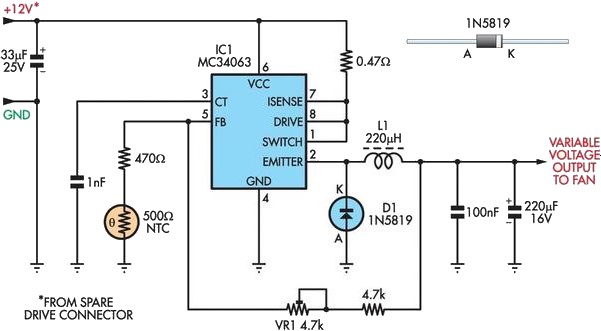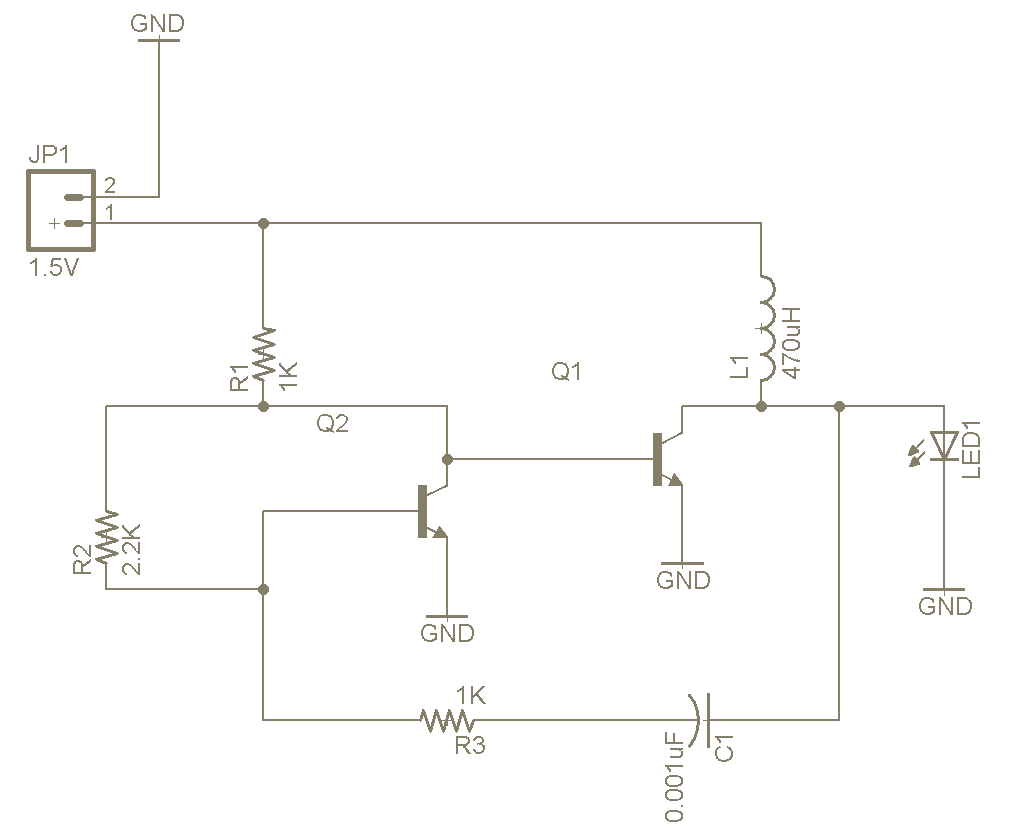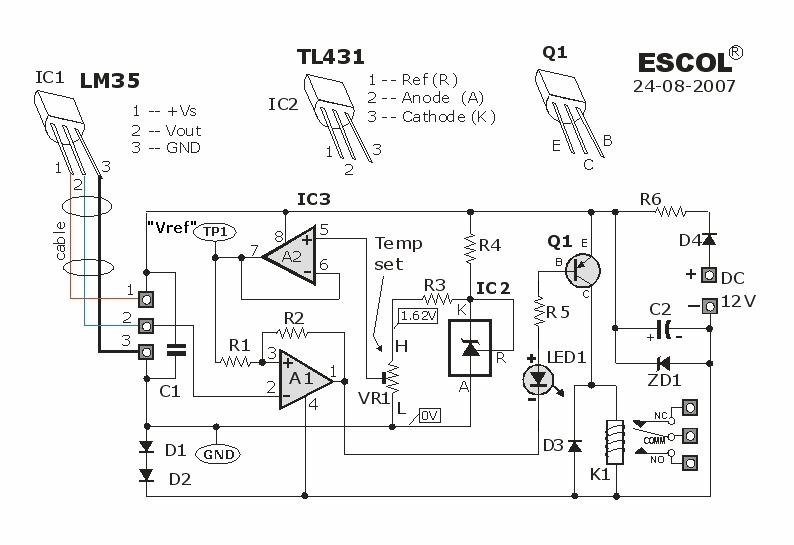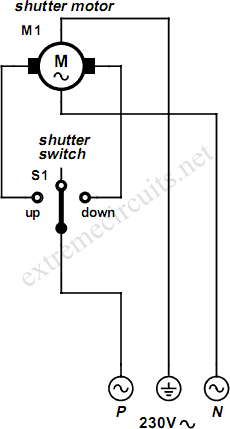
remote control for electrical

A circuit for a remote control unit utilizes radio frequency signals to operate various electrical appliances. This remote control unit features four channels, which can be expanded to twelve. Unlike typical remote control circuits that rely on infrared light for signal transmission—limiting their range and requiring line-of-sight—this circuit employs radio frequency to enable control from virtually anywhere in a home. The control codes are based on DTMF (dual-tone multi-frequency) signals, commonly used in telephone dialing. These DTMF tones are frequency modulated onto a carrier signal. At the receiver end, the frequency modulated signals are intercepted to extract DTMF tones at the speaker terminals. The DTMF signal is then processed by a DTMF-to-BCD converter, with its BCD output controlling the on/off states of various electrical appliances (four in this instance). The remote control transmitter comprises a DTMF generator and an FM transmitter circuit. The DTMF frequencies are generated using the UM91214B IC, typically found in telephone instruments, which operates at 3 volts supplied by a zener diode voltage regulator converting 9 volts. A 3.58 MHz quartz crystal, readily available from electronic stores, serves as the time base. Chip select and DTMF mode select pins are designated as pins 1 and 2. When pins 12 and 15 are shorted, the DTMF tones corresponding to digit 1 are output from pin 7. Additional pins (13, 16, and 17) are designated for dialing digits 2, 4, and 8, while the remaining pins may remain unconnected. The output from the UM91214B is fed into the transmitter circuit, which effectively frequency modulates the carrier signal for air transmission. The carrier frequency is determined by coil L1 and the adjustable trimmer capacitor VC1, which can be set for approximately 100 MHz operation. An antenna measuring 10 to 15 cm (4 to 6 inches) is sufficient for adequate range. The transmitter unit is housed in a metallic cabinet to mitigate frequency drift due to stray electromagnetic fields. Four DPST push-to-on spring-loaded key switches are utilized to transmit the desired DTMF tones; pressing these switches generates the corresponding tone pairs while simultaneously powering the transmitter circuit, thereby conserving battery life when not in use. The receiver unit consists of an FM receiver, a DTMF-to-BCD converter, and a flip-flop toggling latch section. The FM receiver captures the frequency modulated DTMF signals, feeding the output (DTMF tones) to the KT3170 IC, which converts DTMF signals to BCD. For instance, pressing digit 1 outputs 0001, while pressing digit 4 outputs 0100. This IC also requires a 3.58 MHz crystal for operation. The tone input is connected to pin 2, and the BCD outputs are taken from pins 11 to 14. These outputs are directed to four individual D flip-flop latches configured as toggle flip-flops using two CD4013B ICs. When a digit is pressed, the receiver decodes it and generates a clock pulse that toggles the corresponding flip-flop to its alternate state. The flip-flop output drives a relay, enabling the latching or unlatching of any electrical appliance.
The circuit design emphasizes versatility, allowing for the control of multiple devices from a distance. The use of DTMF tones, which are robust against noise and interference, enhances the reliability of the control signals. The integration of a zener diode voltage regulator ensures stable operation of the DTMF generator IC, while the selection of a 3.58 MHz crystal provides precise timing for frequency generation. The configuration of the FM transmitter and receiver facilitates a significant range of operation, making it suitable for use in larger areas without the constraints of line-of-sight that infrared systems impose. The toggle flip-flop arrangement allows for efficient control of appliances, ensuring that they can be turned on or off as needed, providing a practical solution for remote operation of household devices. Overall, the design is characterized by its simplicity and effectiveness, making it an innovative approach in the realm of remote control technology.A circuit of a remote control unit which makes use of the radio frequency signals to control various electrical appliances. This remote control unit has 4 channels which can be easily extended to 12. This circuit differs from similar circuits in view of its simplicity and a totally different concept of generating the control signals.
Usual ly remote control circuits make use of infrared light to transmit control signals. Their use is thus limited to a very confined area and line-of-sight. However, this circuit makes use of radio frequency to transmit the control signals and hence it can be used for control from almost anywhere in the house. Here we make use of DTMF (dual-tone multi frequency) signals (used in telephones to dial the digits) as the control codes.
The DTMF tones are used for frequency modulation of the carrier. At the receiver unit, these frequency modulated signals are intercepted to obtain DTMF tones at the speaker terminals. This DTMF signal is connected to a DTMF-to-BCD converter whose BCD output is used to switch-on and switch-off various electrical appliances (4 in this case).
The remote control transmitter consists of DTMF generator and an FM transmitter circuit. For generating the DTMF frequencies, a dedicated IC UM91214B (which is used as a dialler IC in telephone instruments) is used here. This IC requires 3 volts for its operation. This is provided by a simple zener diode voltage regulator which converts 9 volts into 3 volts for use by this IC.
For its time base, it requires a quartz crystal of 3. 58 MHz which is easily available from electronic component shops. Pins 1 and 2 are used as chip select and DTMF mode select pins respectively. When the row and column pins (12 and 15) are shorted to each other, DTMF tones corresponding to digit 1 are output from its pin 7. Similarly, pins 13, 16 and 17 are additionally required to dial digits 2, 4 and 8. Rest of the pins of this IC may be left as they are. The output of IC1 is given to the input of this transmitter circuit which effectively frequency modulates the carrier and transmits it in the air.
The carrier frequency is determined by coil L1 and trimmer capacitor VC1 (which may be adjusted for around 100MHz operation). An antenna of 10 to 15 cms (4 to 6 inches) length will be sufficient to provide adequate range. The antenna is also necessary because the transmitter unit has to be housed in a metallic cabinet to protect the frequency drift caused due to stray EM fields.
Four key switches (DPST push-to-on spring loaded) are required to transmit the desired DTMF tones. The switches when pressed generate the specific tone pairs as well as provide power to the transmitter circuit simultaneously. This way when the transmitter unit is not in use it consumes no power at all and the battery lasts much longer.
The receiver unit consists of an FM receiver (these days simple and inexpensive FM kits are readily available in the market which work exceptionally well), a DTMF-to-BCD converter and a flip-flop toggling latch section. The frequency modulated DTMF signals are received by the FM receiver and the output (DTMF tones) are fed to the dedicated IC KT3170 which is a DTMF-to-BCD converter.
This IC when fed with the DTMF tones gives corresponding BCD output; for example, when digit 1 is pressed, the output is 0001 and when digit 4 is pressed the output is 0100. This IC also requires a 3. 58MHz crystal for its operation. The tone input is connected to its pin 2 and the BCD outputs are taken from pins 11 to 14 respectively.
These outputs are fed to 4 individual D` flip-flop latches which have been converted into toggle flip-flops built around two CD4013B ICs. Whenever a digit is pressed, the receiver decodes it and gives a clock pulse which is used to toggle the corresponding flip-flop to the alternate state.
The flip-flop output is used to drive a relay which in turn can latch or unlatch any elec 🔗 External reference
The circuit design emphasizes versatility, allowing for the control of multiple devices from a distance. The use of DTMF tones, which are robust against noise and interference, enhances the reliability of the control signals. The integration of a zener diode voltage regulator ensures stable operation of the DTMF generator IC, while the selection of a 3.58 MHz crystal provides precise timing for frequency generation. The configuration of the FM transmitter and receiver facilitates a significant range of operation, making it suitable for use in larger areas without the constraints of line-of-sight that infrared systems impose. The toggle flip-flop arrangement allows for efficient control of appliances, ensuring that they can be turned on or off as needed, providing a practical solution for remote operation of household devices. Overall, the design is characterized by its simplicity and effectiveness, making it an innovative approach in the realm of remote control technology.A circuit of a remote control unit which makes use of the radio frequency signals to control various electrical appliances. This remote control unit has 4 channels which can be easily extended to 12. This circuit differs from similar circuits in view of its simplicity and a totally different concept of generating the control signals.
Usual ly remote control circuits make use of infrared light to transmit control signals. Their use is thus limited to a very confined area and line-of-sight. However, this circuit makes use of radio frequency to transmit the control signals and hence it can be used for control from almost anywhere in the house. Here we make use of DTMF (dual-tone multi frequency) signals (used in telephones to dial the digits) as the control codes.
The DTMF tones are used for frequency modulation of the carrier. At the receiver unit, these frequency modulated signals are intercepted to obtain DTMF tones at the speaker terminals. This DTMF signal is connected to a DTMF-to-BCD converter whose BCD output is used to switch-on and switch-off various electrical appliances (4 in this case).
The remote control transmitter consists of DTMF generator and an FM transmitter circuit. For generating the DTMF frequencies, a dedicated IC UM91214B (which is used as a dialler IC in telephone instruments) is used here. This IC requires 3 volts for its operation. This is provided by a simple zener diode voltage regulator which converts 9 volts into 3 volts for use by this IC.
For its time base, it requires a quartz crystal of 3. 58 MHz which is easily available from electronic component shops. Pins 1 and 2 are used as chip select and DTMF mode select pins respectively. When the row and column pins (12 and 15) are shorted to each other, DTMF tones corresponding to digit 1 are output from its pin 7. Similarly, pins 13, 16 and 17 are additionally required to dial digits 2, 4 and 8. Rest of the pins of this IC may be left as they are. The output of IC1 is given to the input of this transmitter circuit which effectively frequency modulates the carrier and transmits it in the air.
The carrier frequency is determined by coil L1 and trimmer capacitor VC1 (which may be adjusted for around 100MHz operation). An antenna of 10 to 15 cms (4 to 6 inches) length will be sufficient to provide adequate range. The antenna is also necessary because the transmitter unit has to be housed in a metallic cabinet to protect the frequency drift caused due to stray EM fields.
Four key switches (DPST push-to-on spring loaded) are required to transmit the desired DTMF tones. The switches when pressed generate the specific tone pairs as well as provide power to the transmitter circuit simultaneously. This way when the transmitter unit is not in use it consumes no power at all and the battery lasts much longer.
The receiver unit consists of an FM receiver (these days simple and inexpensive FM kits are readily available in the market which work exceptionally well), a DTMF-to-BCD converter and a flip-flop toggling latch section. The frequency modulated DTMF signals are received by the FM receiver and the output (DTMF tones) are fed to the dedicated IC KT3170 which is a DTMF-to-BCD converter.
This IC when fed with the DTMF tones gives corresponding BCD output; for example, when digit 1 is pressed, the output is 0001 and when digit 4 is pressed the output is 0100. This IC also requires a 3. 58MHz crystal for its operation. The tone input is connected to its pin 2 and the BCD outputs are taken from pins 11 to 14 respectively.
These outputs are fed to 4 individual D` flip-flop latches which have been converted into toggle flip-flops built around two CD4013B ICs. Whenever a digit is pressed, the receiver decodes it and gives a clock pulse which is used to toggle the corresponding flip-flop to the alternate state.
The flip-flop output is used to drive a relay which in turn can latch or unlatch any elec 🔗 External reference





